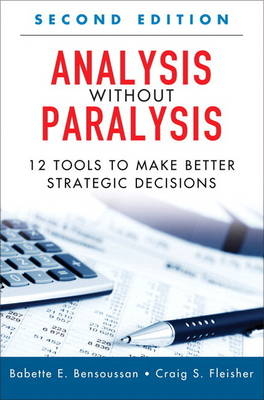
Analysis Without Paralysis
Financial Times Prentice Hall (Verlag)
978-0-13-442629-7 (ISBN)
- Titel ist leider vergriffen;
keine Neuauflage - Artikel merken
"This title should be on any business manager’s shelf wanting to make better decisions using analysis."
--UK Competitive Intelligence Forum (UK CIF)
Babette E. Bensoussan is best known as an international specialist in strategy and competition, and as founder and director of The MindShifts Group. With an excellent breadth and depth of knowledge she has undertaken major studies for and consulted to Australian and Global Fortune 500 companies. She has undertaken over 300 competitive intelligence projects and consulted to a wide range of industries and markets. Babette is a brilliant presenter and communicator, and conducts training, workshops and individual mentoring on a worldwide basis to assist with the development and implementation of competitive strategies, competitive intelligence programs, and strategic planning. Apart from her active business endeavours, Babette has taught Competitive Intelligence in undergraduate business and MBA programs both in Australia and China. In 2012, she was appointed Adjunct Professor, School of Business, University of Technology Sydney. Dr. Craig S. Fleisher is the Chief Learning Officer (CLO) of one of the globe's leading intelligence consultancies, Aurora WDC. Google’s top-cited CI scholar and a frequent keynote speaker, Craig has authored several essential CI books including Analysis without Paralysis 2nd Ed (FT Press, 2013), Business and Competitive Analysis (FT Press, 2007), and Strategic and Competitive Analysis (Pearson, 2003), among others. A former SCIP president, current Fellow and Meritorious Award winner, he was inaugural chair of the Competitive Intelligence Foundation, and founding editor of the Journal of Competitive Intelligence and Management. His PhD in Business is from Pittsburgh's Katz Graduate School of Business. An internationally-focused adviser instructing mainly executive learners, he has held positions including MBA Director, Business School Dean and Chaired Professor at a variety of universities in over half a dozen countries. Bensoussan and Fleisher are also the authors of the well known Business and Competitive Analysis book, a must have for any corporate analyst.
Acknowledgments ix
About the Authors xi
Chapter 1 The Role of Analysis in Business Management 1
The Increasing Need for Effective Analysis 7
Concluding Observations 9
Chapter 2 The Analysis Process 13
What Is Analysis? 16
Chapter 3 BCG Growth/Share Portfolio Matrix 23
Description and Purpose 23
Link to the Experience Curve 24
Link to the Product Life Cycle 25
Combining the Experience Curve and Product Life Cycle 26
Strengths 29
Weaknesses 30
How to Do It 32
Case Study: Google as Viewed in a BCG Portfolio Planning Matrix 39
Chapter 4 Competitor Analysis 45
Description and Purpose 45
Strengths 47
Weaknesses 47
How to Do It 48
Case Study: Chinese Mobile Phone Market 59
Chapter 5 Driving Forces Analysis 63
Description and Purpose 63
Strengths 64
Weaknesses 65
How to Do It 66
Case Study: Driving Forces in the Digital Music Market 75
Chapter 6 Financial Ratios and Statement Analysis 81
Description and Purpose 81
Basic Concepts Underlying Financial Ratio and Statement Analysis (FRSA) 81
Components of Financial Statements 82
Assessing the Appropriateness of Ratios 83
Strengths 84
Weaknesses 84
How to Do It 86
Activity or Efficiency Ratios 87
Leverage or Solvency Analysis Ratios 90
Liquidity Analysis Ratios 91
Profitability Analysis Ratios 93
Other Analysis Ratios: Capital Market or Shareholder Returns 95
Methods of Ratio or Measure Comparison 98
Consolidation and Segmented Analysis 102
Case Study: FRSA of the Three Large North American Warehouse Clubs 104
Chapter 7 Five Forces Industry Analysis 109
Description and Purpose 109
Threat of New Entrants 111
Bargaining Power of Suppliers 112
Bargaining Power of Buyers 113
Threat of Substitute Products or Services 114
Degree of Rivalry Among Existing Players 115
Strengths 116
Weaknesses 117
How to Do It 118
Case Study: Applying the Five Forces Model to the U.S. Passenger Airline Industry 120
Case Study: Applying the Five Forces Model to the Global Pharmaceutical Industry 123
Chapter 8 Issue Analysis 127
Description and Purpose 127
Strengths 129
Weaknesses 130
How to Do It 131
Examples of Issue Analysis in Practice 144
Chapter 9 Product Life Cycle Analysis 147
Description and Purpose 147
Strengths 156
Weaknesses 157
How to Do It 158
Case Study: Apple’s Product Life Cycles and Growth Potential from the iPod to the iPad 163
Endnotes 165
Chapter 10 Scenario Analysis 167
Description and Purpose 167
Methods for Generating Scenarios 168
Strengths 172
Weaknesses 173
How to Do It 174
Case Study: Scenarios for Traditional and Emerging Forest Products Enterprises 179
Endnotes 184
Chapter 11 Macroenvironmental (STEEP/PEST) Analysis 187
Description and Purpose 187
Strengths 191
Weaknesses 192
How to Do It 193
Case Study: STEEP Analysis of the Life and Death of Brands 197
Chapter 12 SWOT Analysis 199
Description and Purpose 199
Strengths 202
Weaknesses 202
How to Do It 204
Case Study: Lockheed Martin Corporation 213
Endnote 222
Chapter 13 Value Chain Analysis 223
Description and Purpose 223
Strengths 229
Weaknesses 230
How to Do It 231
Case Study: Value Chain Analysis of Walmart Stores 242
Chapter 14 Win/Loss Analysis 249
Description and Purpose 249
Strengths 250
Weaknesses 252
How to Do It 254
Win/Loss Case Study: Email Marketing Solutions 260
Index 263
| Erscheinungsdatum | 31.12.2015 |
|---|---|
| Verlagsort | Upper Saddle River |
| Sprache | englisch |
| Maße | 145 x 231 mm |
| Gewicht | 394 g |
| Themenwelt | Informatik ► Datenbanken ► Data Warehouse / Data Mining |
| Informatik ► Office Programme ► Outlook | |
| Mathematik / Informatik ► Mathematik ► Finanz- / Wirtschaftsmathematik | |
| Wirtschaft ► Betriebswirtschaft / Management ► Unternehmensführung / Management | |
| ISBN-10 | 0-13-442629-0 / 0134426290 |
| ISBN-13 | 978-0-13-442629-7 / 9780134426297 |
| Zustand | Neuware |
| Haben Sie eine Frage zum Produkt? |
aus dem Bereich


